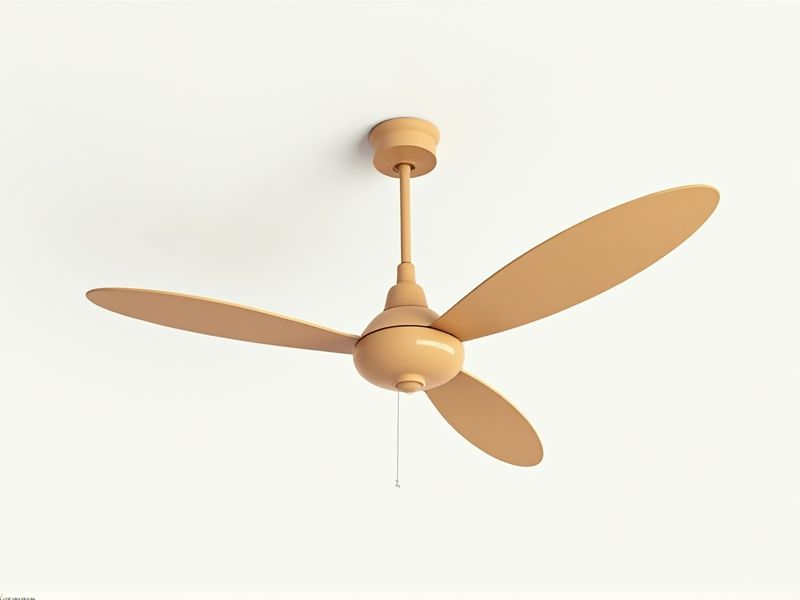
When selecting a ceiling fan, knowing the standard dimensions can help you find the right fit for your space. Most residential ceiling fans have blade spans ranging from 36 to 56 inches, with 52-inch fans being the most common for medium-sized rooms. The recommended distance from the floor to the fan blades is typically 7 to 9 feet, while the distance from walls should be at least 18 inches to ensure proper airflow and safety. Measure your room's size and ceiling height to choose a fan that delivers both comfort and style without overwhelming the space.
Blade Span
The blade span of a ceiling fan significantly influences its airflow efficiency and cooling capability. Typically, blade spans range from 36 to 56 inches, with larger spans ideally suited for larger rooms to enhance air circulation. A fan with a 52-inch blade span is optimal for average-sized rooms of about 100 to 250 square feet, providing comprehensive ventilation. Your choice of blade span can dramatically impact the overall comfort level and energy consumption in your space.
Downrod Length
The downrod length of a ceiling fan is critical for optimal air circulation and aesthetic appeal, typically ranging from 3 to 72 inches. For standard ceilings of 8 to 9 feet, a downrod length of 12 to 18 inches is recommended to ensure the fan operates effectively and safely. If your ceiling is 10 to 12 feet high, consider using a downrod of 36 inches or longer to maintain proper airflow. Proper downrod selection enhances energy efficiency, noise reduction, and the overall performance of the ceiling fan, making it an essential factor in your installation decision.
Motor Size
The motor size in ceiling fans is crucial for determining the fan's efficiency and airflow performance. Typically, motor sizes range from 36 to 60 inches in diameter, with larger motors providing more airflow, measured in cubic feet per minute (CFM). For optimal energy efficiency, look for fans that operate at 50-150 watts, balancing power consumption with air movement. A fan with a larger motor can circulate air effectively in spaces above 400 square feet.
Blade Pitch
The blade pitch of a ceiling fan is crucial in determining its efficiency and airflow capabilities, typically measured in degrees. A blade pitch ranging from 12 to 15 degrees is optimal for most residential settings, providing a balance between air circulation and energy consumption. Fans with a higher blade pitch can move more air but may require more power, impacting energy costs. For optimal performance, ensure that your ceiling fan has adjustable speeds to accommodate varying needs in different seasons.
Blade Material
The blade material of a ceiling fan significantly influences its performance and durability, with options such as wood, plastic, and metal each offering distinct advantages. Wooden blades, typically crafted from high-quality hardwoods, provide a classic aesthetic and superior airflow, while also mitigating noise levels during operation. In contrast, plastic blades are lightweight, resistant to moisture, making them ideal for humid environments, and require less maintenance over time. Metal blades, often used in industrial-style fans, deliver powerful airflow and durability but may generate more noise; you should consider the space and style when selecting the right blade material for your ceiling fan.
Mounting Type
Ceiling fans are commonly categorized by their mounting types, which significantly influence installation and performance. The three main mounting options are flush mount, downrod mount, and angled mount, catering to various ceiling heights and room configurations. For ceilings lower than 8 feet, a flush mount fan is ideal as it sits close to the ceiling, while downrod mounts are suitable for higher ceilings, typically 9 feet or more, providing optimal airflow. When selecting a ceiling fan, consider your room's ceiling height and desired aesthetics to ensure effective air circulation and energy efficiency.
Ceiling Height Compatibility
Ceiling fans are designed to accommodate various ceiling heights for optimal airflow and aesthetic appeal. For ceilings under 8 feet, low-profile fans are recommended to maintain safety and efficiency, usually with a mounting height of about 7 feet from the floor. Fans installed in ceilings between 8 to 9 feet require a downrod for better air circulation, with downrod lengths commonly ranging from 6 to 24 inches. For ceilings exceeding 9 feet, downrods ensure proper fan positioning, improving air movement and enhancing your overall comfort.
Airflow Efficiency
An efficient ceiling fan delivers optimal airflow, measured in cubic feet per minute (CFM), ensuring maximum ventilation while consuming minimal energy. A fan with a CFM rating of 5,000 or higher is considered high-performance, providing effective cooling for large rooms. To further enhance efficiency, selecting a fan with an Energy Star certification can save you up to 60% on energy costs compared to standard models. Operating in conjunction with your HVAC system can also improve overall comfort by circulating air evenly throughout your space.
Number Of Blades
A ceiling fan typically features 3 to 5 blades, with an increase in blade count often correlating with enhanced airflow and efficiency. Fans with 5 blades may create a quieter operation while still ensuring optimal air circulation, making them a popular choice for residential spaces. The blade material, ranging from wood to metal, can also impact performance; for instance, wooden blades tend to be heavier but provide a more stylish finish. When selecting a ceiling fan, consider not just the blade count but also the motor speed, which can vary significantly among models, affecting overall cooling effectiveness.
Energy Consumption
Ceiling fans typically consume between 50 to 100 watts of electricity during operation, with energy-efficient models using as little as 30 watts. By choosing an Energy Star-rated ceiling fan, you can reduce your energy consumption by about 20-50% compared to conventional models. These fans are designed to optimize airflow while minimizing power usage, making them an excellent choice for cooling your home without significantly impacting your electricity bill. You might also consider using energy-efficient LED bulbs in the fan's light fixture, which can save an additional 75% in lighting energy costs.
